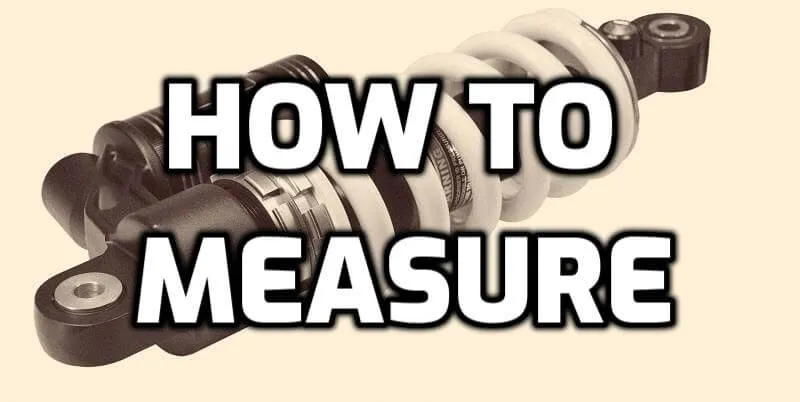How to Measure Your Shocks

Shock absorbers are a vital safety feature on your vehicle. The shock absorber prevents the springs from being able to bounce back and forth too much, which could cause them to break or wear out prematurely.
Shock absorbers also control how quickly your car rebounds after going over bumps in the road, making it easier for you to drive smoothly. In this post we will show you step by step how you can measure shocks on your own with two simple tools!
Step 1: Park the car on a level surface. For the front and rear shocks, measure the distance between the lower shock mount and the upper mount. Make a note of this information. The “static” measurement is this distance.
Step 2: Locate the rubber bump stop on the front suspension, which is usually a disc of soft rubber. Determine how far away from the rubber bumper stop you are when making contact with it. The front bumper stop frequently strikes the lower control arm, while the rear bumper hit frequently makes contact with the rear axle tube. Make a note of this.
Step 3: Subtract the bump stop measurement from the static measurement. This is the compressed height of the shock. For example, if your front shock’s static height is 14-inches and the bump stop distance is 4-inches, then its compressed height is “14-4=10,” or 10-inches.
Step 4: Raise the vehicle’s front until the tire is off the ground. Count the distance between the top of the shock mount and its lower counterpart. Then lower the car. The longer measurement for the front shock is this point.
Step 4: Raise the rear of the vehicle until the tire is clear of the ground. Take note of the distance between the top shock mount and the bottom shock mount. Then lower the vehicle once you’ve taken note of it. The rear suspension has an extended measurement, as shown in this image.
Pro Tips: Shock absorber comes with the perfect size for your vehicle requirement. So that you can get the perfect fit of shock absorber for your vehicle.
Best Shocks for 6 Inch Lifted Trucks
Driving a truck is challenging enough, but driving one with the wrong shocks can make it even more difficult. This article will provide you with some information on what to look for when purchasing new shock absorbers and how to determine if your vehicle has been lifted or not.
- Bilstein 5100 Monotube Gas Shocks
- Rough Country N3 Rear Shock Absorbers 4-8″ Lift
- Bilstein 5100 Gas Shocks Set 4WD
- Rancho RS5000X Gas Shocks 4-Pack Set
- Fox 2.0 Performance Shocks 4-Piece Kit
- Rancho RS5000X Gas Shocks for 1999-2006 Chevy Silverado 1500
Bilstein 5100 Monotube Gas Shocks: These are high-quality, OE replacement shock absorbers. They are designed to provide the best performance for most pickup trucks and cars with moderate off-road use.
Rough Country N/X Series Shocks: This is an adjustable gas shock with external reservoirs that enhance damping control through specially calibrated valves. It comes with nitro steel alloy shafts and multi-stage velocity-sensitive valving.
Bilstein 5100 Gas Shocks Set 4WD: This is a set of four front shocks that are OE replacement items. They have super low-pressure gas and nitrogen-charged to resist oil foaming and aeration during heavy use, which keeps the shock absorbers responsive even when you’re driving on long trips with lots of bumps in the road.
Rancho RS5000X Gas Shocks 4-Pack Set: This four-shock absorber pack offers an economical replacement option for shocks and struts with worn-out factory units. The RS5000X has nitrogen gas-charged, multi-stage velocity sensitive valving to offer years of worry-free performance even on the roughest roads.
Fox Racing Shocks: These are rear monotube style shocks that are designed to offer high-quality performance while being easy on the wallet. They come with an all-aluminum body and piston, along with 16 position compression adjustability options.
Rancho RS5000X Gas Shocks for 1999-2006 Chevy Silverado 1500 can be used as replacements or spares for stock units that have deteriorated over time. They are equipped with nitrogen-charged, multi-stage velocity sensitive valving to offer years of worry-free performance even on the roughest roads.
Conclusion:
I hope this guide will help you to measure your shocks on your own. This post has shown you step by step how to measure shocks on your own with two simple tools! If you find this useful, please share it as well so that other people can also benefit from this guide.
Thank you very much for reading my article and see you again next time! If you have any more questions, please do not hesitate to email me! Thank You for Reading! Have a Good Day 🙂
Frequently Asked Questions (FAQ)
1. Have your helper hold one end of the measuring tape at the bottom of the tire, while you hold the other end at the top of the tire.
2. Measure the distance between the two ends of the measuring tape.
3. Repeat steps 1 and 2 for the other shock absorber.
4. Compare the two measurements to see if they are equal. If they are not, then your shock absorbers may need to be replaced.
Related Article
